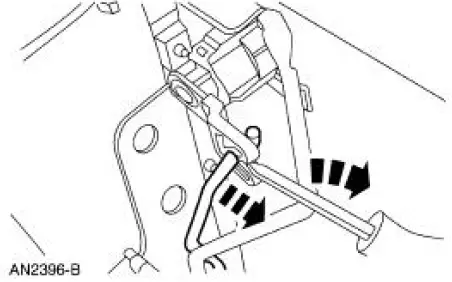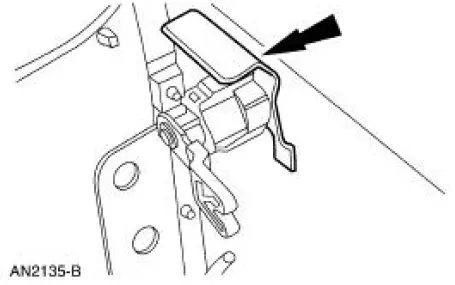Ford Mustang (1999-2004) Service Manual: Lock Cylinder - Door
Removal
1. NOTE: Individual lock cylinders are repaired by discarding the inoperative cylinder and building a new lock cylinder using the appropriate lock repair package. The lock repair package includes a detailed instruction sheet to build the new lock cylinder to the current key code of the vehicle.
Remove the door trim panel (23942). For additional information, refer to Section.
2. Using a screwdriver, release the lock cylinder actuating rod.

3. Remove the door lock cylinder retainer.

4. Remove the door lock cylinder (21990).

5. If necessary, transfer the lock cylinder arm to the new door lock cylinder (21990).
Installation
1. To install, reverse the removal procedure.
 Ignition Lock Cylinder - Non-Functional
Ignition Lock Cylinder - Non-Functional
Removal and Installation
1. NOTE: Make sure the front wheels are in the straight-ahead
position.
Disconnect the battery ground cable (14301) and wait at least one minute
to allow the deplet ...
 Lock Cylinder - Luggage Compartment Lid
Lock Cylinder - Luggage Compartment Lid
Removal
1. NOTE: Individual lock cylinders are repaired by discarding the
inoperative cylinder and building
a new lock cylinder using the appropriate lock repair package. The lock
repair pac ...
Other materials:
Synchronizers
Disassembly
NOTE: This procedure applies to all synchronizer assemblies
(7124). The synchronizers are slightly
different in design. Notation is made where procedural differences occur.
1. On the third/fourth speed synchronizer and the fifth speed
synchr ...
Input Shaft and Bearing
Special Tool(s)
Plate, Bearing/Oil Seal
205-090 (T75L-1165-B)
Puller, Bearing
205-D064 (D84L-1123-A)
Installer, Drive Pinion Bearing
Cone
205-004 (T53T-4621-B)
Adapter Set, Step Plate
205-DS011 (D80L-630 ...
Knock
Knock, which can occur on all driving phases, has several causes including
damaged teeth or gearset.
In most cases, one of the following conditions will occur:
1. A gear tooth damaged on the drive side is a common cause of the knock.
This can usually be
cor ...
